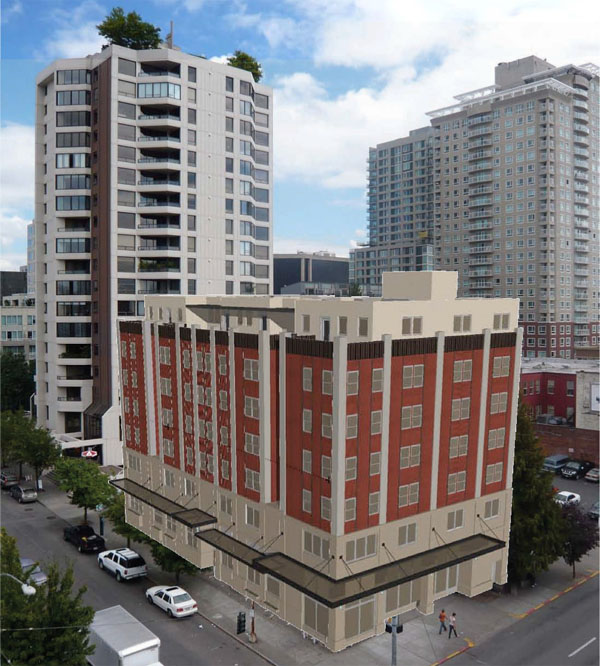No Parking Baby

[ Rendering of Plymouth Housing Group’s homeless housing project at 1st and Cedar; SMR Architects ]
Listen:
“No parking, either long-term or short-term, is required for uses on lots in downtown zones.”
So dictates Seattle code. But as far as I know, only one new significantly sized project has yet to take the cue: Plymouth Housing Group’s proposed seven-story mixed-use building at 1st and Ceder (unflatteringly rendered above), scheduled for completion in 2010. Designed by SMR Architects, the building is to provide 84 studio residences for the homeless, along with 2000 square feet of street level retail. Given the clientele, the undoubtedly tight construction budget, and the excellent access to transit, no parking makes several kinds of sense for this project.
The City of San Francisco implemented a parking maximum of 0.75 spaces per unit in downtown areas, but buildings with no parking are still a rarity. One particularly impressive example is Curran House (photo below), an affordable housing project designed by David Baker+Partners:
“Curran House has no on-site automobile parking, which seems like a crazy idea in the modern USA, but made sense here because: most of the residents can’t afford a car, the site has excellent public transit connections, and we were able to provide additional units, gardens, common space for supportive services, neighborhood-serving retail, and office space for TNDC. Additionally, providing parking minimums would have added several million dollars to the construction cost, while ample monthly parking is available for lease in the immediate neighborhood at reasonable rates.”
As for no parking in market rate housing, well, let’s just say we’ve got a whole lot more CO2 to emit from our cars before that’s going to happen. In Seattle, ratios as low as about one space per unit are becoming more common. The lowest I’ve come across is Moda, in which 83 of 251 units have no on-site parking. In a Portland condo project called The Civic, 24 of 261 units were set aside to be sold without on-site parking spaces.
Cars and lenders are not about relent on their collusion to maximize parking any time soon. But given that below grade structured parking typically costs about $40,000 per stall, and given that we have a shortage of affordable housing in Seattle, and given that we all know that the sun is setting on the age of oil, the least we could do is start removing minimum parking requirements in Seattle city-wide. Downtown was a good first step, but because land costs are so high, projects are more likely aimed at high-end markets, which demand, and can absorb the additional cost of structured parking.Â
Miniumum parking requirements were recently removed in Seattle’s four urban centers and the light rail station areas–very good moves.  Why not urban villages too? And how long before we move toward parking maximums?

[ Curran House in San Francisco, designed by David Baker+Partners;Â photo by Brian Rose ]
